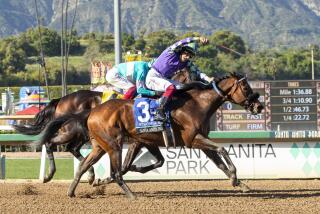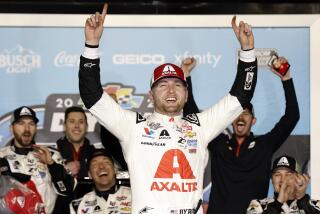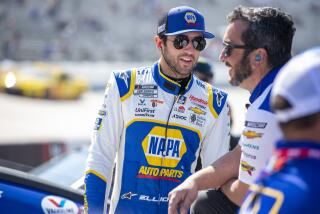NASCAR and Imax have formed a winning team
Stock car racing and Imax 3-D were made for each other, what with cars speeding up to 200 mph in three dimensions on a giant seven- or eight-story screen. What is surprising about “NASCAR: The Imax Experience” is that it is as informative as it is exciting. To be sure, a tire, blown loose from a car, appears to hurtle over the heads of the audience; sometimes the race track seems to be at the level of the viewer’s chin; and of course, the film puts the audience in the driver’s seat.
Yet in an amazingly compact 47 minutes, veteran director Simon Wincer outlines the history of the sport, evokes its culture and packs it with jaw-dropping statistics while never slackening the pace. Wincer shrewdly does not stop his picture in its tracks for the usual talking heads. He’ll introduce a key figure and let him continue his remarks on the soundtrack while keeping things moving.
Kiefer Sutherland’s narration is brisk and clear, and James Neihouse’s 3-D cinematography dynamic and graceful.
“NASCAR: The Imax Experience” is a splendid example of pure cinema, but it is not exclusively devoted to races in progress. Instead, it succinctly introduces us to the sport and its history, steadily building to a concluding race composed of images taken at various tracks, a democratic way of suggesting the wide range of stock car racing’s appeal.
It opens on a dirt road in the Blue Ridge Mountains with young moonshiners in a souped-up vintage car outrunning the sheriff in homage to legendary Junior Johnson’s emergence from whisky runner to winner of 50 NASCAR titles.
From such roots in post-World War II America the sport became formalized with the running of the Daytona 500 in 1959. Today, 43 of America’s best stock car drivers compete in races 38 weeks of the year in tracks all over the country in what has become the largest spectator sport in the U.S.
More than one official acknowledges that the sport is “incredibly dangerous,” but the film takes pain to emphasize safety precautions taken in the construction of the stock cars in the fabled racing shops of Mooresville, N.C.
There’s no way around noting the death of Dale Earnhardt Sr., but this film is an unabashed celebration -- indeed, a promotion -- and not an investigation of the sport.
Not surprisingly, there is no discussion of the circumstances of Earnhardt’s death on the track, how it might have been prevented, what safety measures have been taken in its wake and what further measures could be and need to be taken. At the same time the film is honest enough to record the admissions of the fear and tension the wives of the racers live with. “I don’t know how I would tell my children if something happened to their father,” admits one wife.
“NASCAR: The Imax Experience,” however, really does capture the intoxicating thrills the sport offers to racer and spectator alike, and it shows that it is deep in the American grain, a family occasion intermingled with prayers and patriotism along with hot dogs and beer. Stock car racing is such an expensive sport -- a single event wears out a million dollars’ worth of tires; the payroll at Dale Earnhardt Enterprises in Mooresville is $16 million -- it’s no wonder sponsor ads cover much of the cars, 76-foot-long haulers, concession vans and so forth.
(One concession stand boasts a huge banner emblazoned with the single word, “Rubbermaid,” whose products one does not immediately associate with stock car racing.)
Apart from capturing the excitement of the sport, the film’s key accomplishment is to make the point that NASCAR racing is a team sport -- that the pit crew is as important as the driver whose name may become a household word even in homes where little or nothing else is known about stock car racing beyond that it is dangerous. One veteran observes that everything has to be great -- the driver, the pit crew, the vehicle, etc. -- and that if that is the case, “You just might win.”
*
‘NASCAR: The Imax Experience’
MPAA rating: PG for some car crashes
Times guidelines: Suitable family fare
A Warner Bros. Pictures presentation of an Imax Corp. production in association with NASCAR. Director Simon Wincer. Producers Lorne Orleans and Douglas (Disco) Hylton. Executive producer Neil Goldberg. Narration written by Mark Bechtel. Cinematographer James Neihouse. Editor Terry Blythe. Music Eric Colvin. Consultant Jeff MacGregor. Narrator Kiefer Sutherland. Running time: 47 minutes.
At selected Imax theaters.
More to Read
Only good movies
Get the Indie Focus newsletter, Mark Olsen's weekly guide to the world of cinema.
You may occasionally receive promotional content from the Los Angeles Times.









